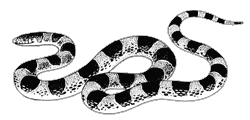Longnose Snake
(Rhinocheilus lecontei)
Order: Squamata
Family: Colubridae (colubrid snakes)
Spanish names: coralillo
Distinguishing Features
This slender snake reaches lengths of slightly over 3 feet (90 cm). While there is considerable variation in pattern and color, generally this snake is banded or blotched with black, white, and usually red; red may be entirely absent in some individuals. The belly is cream or yellowish with some dark spotting on the sides. The lower jaw is countersunk. This snake is easily confused with the venomous coral snake due to the similarity in color banding pattern. The longnose snake can be distinguished from the coral snake by its long nose, its light colored flecking on the nose (within dark fields) and by body bands that do not completely encircle the body. Additionally, color sequencing is generally different.

Range
The longnose snake is found throughout the southwestern United States, in northern Baja California, and south to San Luis Potosí and southern Taumalipas in Mexico.
Habitat
The longnose snake is found in desertscrub, grassland, chaparral, and tropical habitats below 5400 feet (1650 m). It prefers brushy, rocky areas.
Life History
When disturbed, the longnose snake writhes and twists its body, vibrates its tail, and defecates feces and blood from its anal opening. An excellent burrower if the soil is sandy, it can also retreat under rocks or into rock crevices or rodent burrows, if necessary. In warmer parts of its range, the longnose snake may lay 2 clutches of 4 to 11 eggs per year, while in cooler portions of its range only 1 egg clutch per year is laid. Active primarily at night, it feeds on many things including lizards, lizard eggs, small snakes, small mammals, and sometimes birds.










